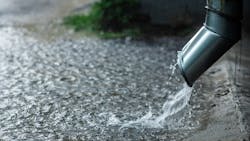Leading members of the National Association of Clean Water Agencies (NACWA) are drawing attention to the impact of major rain and flood events on the nation’s clean water infrastructure.
Examining 10 major rain and flood events in 2022 and exploring how the aggregate effect of climate change and fresh operational challenges in the water sector, NACWA’s expressed concern about a federal funding gap for clean water infrastructure at a national news conference.
Marking the 50th anniversary of the Clean Water Act, NACWA’s member utilities from Washington, D.C., Chicago, and Seattle celebrated local victories, while expressing concern that the cost of providing clean and safe water continues to increase year over year, along with the household cost for accessing such water.
Despite industry-wide accolades for President Biden’s $55 billion commitment to clean water laid out in the Bipartisan Infrastructure Law, NACWA says the U.S. faces a water infrastructure funding gap of nearly $1 trillion over the next two decades.
“Local ratepayers (the public) are currently largely footing the bill to fund urgently needed updates to our clean water infrastructure,” says Kishia L. Powell, COO and executive vice president of D.C. Water in Washington, D.C. “In the District of Columbia, where we work, and other U.S. cities, we witness many lower income families paying a disproportionately large share of their income for clean water service. These families face difficult choices between paying for clean water for their families or paying for another crucial need, such as electricity, food, or medicine.”
2022 saw a historic level of flooding and extreme weather, and water utilities were faced with increasing pressure on infrastructure not designed for the effects of climate change. NACWA members pointed to recent events to underscore the imperative that federal government investments for water infrastructure are needed more than ever to increase resilience and protect public health in the face of natural disasters.
“Many American cities, especially older cities in the Midwest utilizing combined sewer and stormwater systems, are at great risk from overflows," says Brian Perkovich, executive director of the Metropolitan Water Reclamation District of Greater Chicago. "With climate change, we are experiencing higher volumes of rain at quicker intervals. While funding authorized under the Bipartisan Infrastructure Law is helpful, these funds are nowhere near enough to address stormwater management challenges nationwide. In Chicago, we are spending significant resources to protect our water environment and the region from flooding. To help Chicago and our colleagues across the country with the resources and tools we need to mitigate climate impacts, increase resiliency, and stop sewage overflows, Congress must fully appropriate the necessary funding in a future spending bill."
During the news conference, NACWA issued a fact sheet: “10 Extreme Rain and Flood Events in the U.S. – All in 2022,” which included estimates on damage costs and information on how water treatment facilities and other water infrastructure have been impacted. Events included Hurricane Ian, combined flood and rain events in Jackson, Miss., Dallas, Texas, Eastern Kentucky, St. Louis, Mo., Yellowstone National Park, Georgia, Alaska, Puerto Rico, and Death Valley, N.M.
Key findings from the new NACWA report on 1,000-year rain and flood events in 2022 include:
On September 28-30, in one of the costliest storms in U.S. history, Hurricane Ian cause an estimated $60 billion in damage. Early reports show hat at least a dozen wastewater treatment plants needed to release raw or partially treated sewage due to powerful downpours from Hurricane Ian, threatening public health and rescuers that had to wade through the tainted floodwaters in Collier County, Lee County, and Sarasota County, which all issued boil water notices.
On August 24-25, a 1,000-year rain event in Jackson, Mississippi cause an estimated $1 billion in damage. Jackson suffered from complete failure of its water infrastructure and was on a boil water advisory for two months. This failure stems from long term disinvestment in the water utility and a severe winter storm in 2021. The extreme weather event served to exacerbate an existing infrastructure failure, which has resulted in 300 boil water advisories over the last two years
On August 21-22, combined 1,000-year flood and rainfall events in Dallas caused between $4.5-6 billion in damage. Dallas Water Utilities stated that the city’s drainage system, which was built in the 90s, is no longer adequate for the more frequent and intense storms Dallas is set to experience in the future, combined with the massive development and increases in impermeable surfaces in the watershed in that time.
On August 5, 2022, a 1,000-year rain event in Death Valley, New Mexico caused more than $12 million in damages. Flooding in Death Valley caused a major break in the water line for the Cow Creek Water system, which provides water for park residents and offices. This line break caused a complete system failure during the flood.
On July 26-30, combined 1,000-year flood and rainfall events in Kentucky caused $16.8 million damage to water infrastructure, impacting water treatment facilities and other water infrastructure. Water infrastructure in Perry County, Kentucky was “totally annihilated” by flash floods, and parts of some Kentucky counties could go without water service for 6 months to a year.



